How To Build MVP – Step by Step Guide for Startups 2024
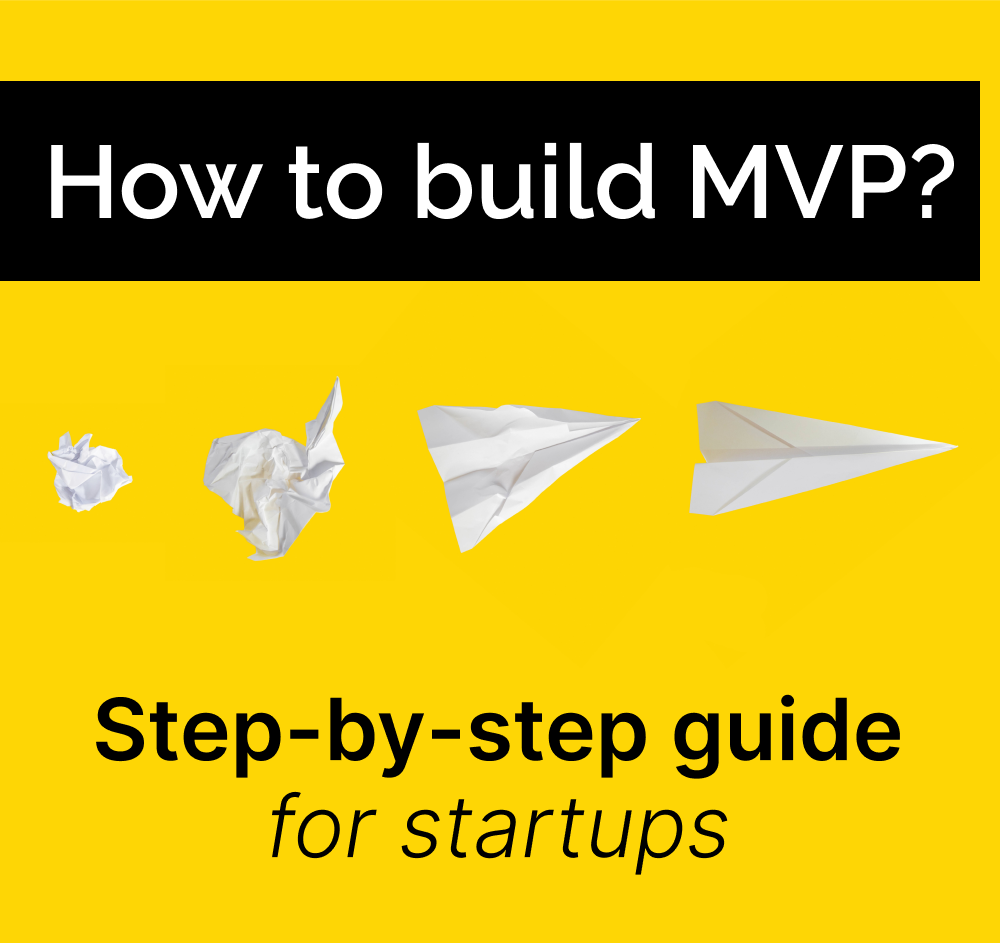
Building a Minimum Viable Product (MVP) is a core part of the startup development strategy that we use at AMgrade. However, creating and launching an MVP project for a startup might have some pitfalls and raise a lot of questions. To avoid confusion and help you to learn how to build a successful minimum viable product, we would like to clarify in this article:
- What Is a Minimum Viable Product
- What Are MVP Project Benefits
- Types Of MVPs
- Minimum Viable Product Examples
- Steps To Build an MVP For Startups
- Success Metrics of Minimum Viable Product
- Common Mistakes That Can Cause MVP Startup Failure
- Conclusion
But before we begin, here are some materials you might also need:
- 7 Steps of Project Discovery Phase You Should Know to Avoid Failure
- Software Requirements Specification – Why does your startup need it? How to make it right?
- Monetization. Or What is Pricing Strategy and why it’s important to work on it for Startup?
- From MVP launch to first active users. What’s next?
- How to hire a dedicated development team: 9 steps to simplify the hiring process
1. What Is a Minimum Viable Product
Building an MVP for a startup would be the best solution if you have a fantastic product idea but need to raise money to bring it to life. A Well thought-out MVP launch strategy would help you to find and secure investors when you are on a tight budget. But what does MVP mean?
(MVP) minimum viable product is an early version of a product or concept. Launched minimum viable website or app gives startup entrepreneurs crucial feedback. That feedback creates confidence that the product is needed on the market and direction for further development.
Frank Robinson was the first one who coined and defined the term MVP – a minimum viable product in 2001. Steve Blank and Eric Ries started to use it and really popularized it in 2009-2010. A successful entrepreneur and author of “The Lean Startup” book said:
The minimum viable product is that version of a new product which allows a team to collect the maximum amount of validated learning about customers with the least effort.
Eric Ries
Eric Ries’s MVP theory underlines that companies should be ready to face the challenges of implementing any MVP, and the biggest one is missing customer interest. Both he and Blank agree that an MVP project should be used as an experiment that clarifies how customers will receive a basic idea. Ries ads, “It lets you know whether you’re making progress and to decide whether you need to pivot.”
Usually, MVP is a website or an app with minimum features to attract early users. The company could choose the main feature that makes the differentiation and see if it resonates with the market. Thus, building an MVP validates an idea in the early phases of the discovery and development process. You can read more about Project Discovery Phase here. The MVP stands for the fastest and cheapest way to test the assumptions and check if the users actually want this solution.
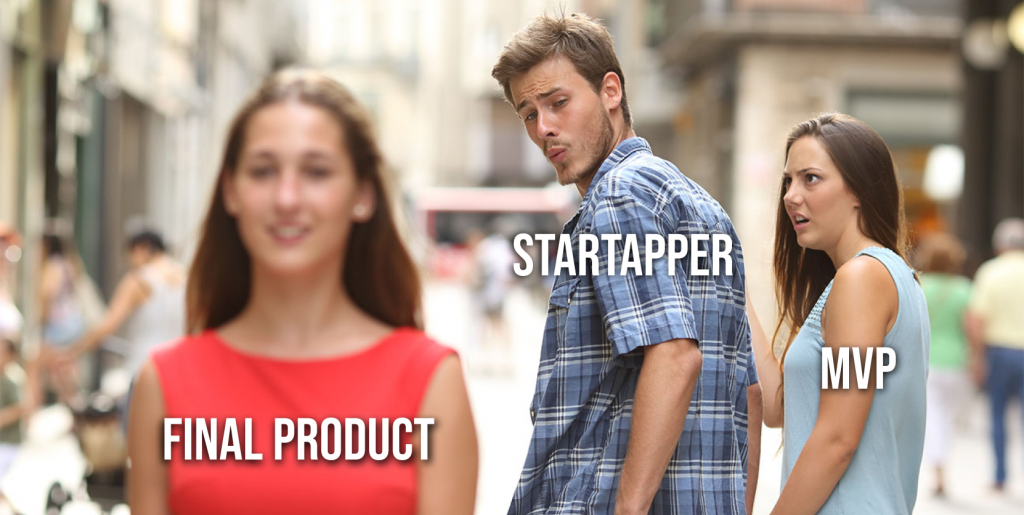
2. What Are MVP Project Benefits
If you doubt whether it’s reasonable to use a Minimum Viable Product approach for your startup or whether you should go with the full implementation, let’s take a look at the MVP’s benefits and deliverables.
- Clarity of Core Value of Your MVP Startup. As you start to build an MVP product, you start to shape and polish the key concept of your idea. Such a focused vision will undoubtedly help you to stay on the right track and make better decisions in the long run.
- Focus on Key Functionalities with MVP Development. When you start to think about your finished product, usually you imagine a huge number of features and functions. In this way, it is easy to lose focus on the specific problem you aim to solve. When your product’s purpose is highlighted and kept clear, any excess features are pushed back, and your developers won’t get side-tracked working on distractions.
- Build Early Relationships with Your Audience and Brand Advocates. Engaged initial users will spread the word about your product within their communities. What could be better than a product appealing to your target audience?
- Customer-Oriented MVP Product as a Deliverable. Your users will hint at which functionality is really needed, what they appreciate the most, what is not so important, and what features you should add in the next release.
- Clear User Interface of MVP website or app. Today’s UI trend is a clear and simplified interface that perfectly matches the MVP concept. To know more about The Latest UI/UX Trends read here. Easily adopted and not complicated in usage, Minimum Viable Product without unwanted features would definitely encourage and engage your users. They would start testing the product right away.
- Quicker Time to Market. There is always somebody who can release very similar, good products before you. Minimum Viable Product allows you to keep your initial release minimal and fast.
- Reduces Rework Time. It’s normal when newly released products have some bugs and hiccups. It is the way of evolving and becoming outstanding. Simple MVP helps to find and fix bugs more easily.
- Flexibility and Constant Updates of Viable Product. MVP startup benefits from the newer technology and tools that customers request. It will help you to keep the product relevant in the market. It allows you to release iterations and learn from your mistakes quickly.
- MVP Development with Minimal Risks. As we showed you in the examples, the most used and popular software products started from small and adopted costly, extensive features over the years.
- Boosting Brand Recognition. By launching an MVP, your business can immediately begin generating brand awareness and buzz around what you’re doing. As initial adopters start interacting with your product, you’ll create a snowball effect as they begin to tell people about it.
- Verifying a Monetization Strategy for MVP Development. There are multiple product monetization strategies, and deciding which is best can often be tricky. The right approach in this scenario for your startup is to test different tactics and assumptions with a Minimum Viable Project.
- Finding Investors for Your MVP Startup. An MVP launch strategy could make or break a deal with the investors. Investors would rather invest their money in something they can see, touch, and use immediately. Furthermore, they want to see some revenue evidence before they board. A high-quality MVP development delivers a solid business case that demonstrates the market validity of the product and a faster return on their investment.
Need consultation about MVP approach?
3. Types of MVPs
There are multiple approaches to MVP software development. Each of them serves different purposes and gives different results. To be sure that you are not wasting your resources, it is important to overview the most popular ones and understand their impact on further product development.
Generally, we can define minimum viable products in two categories – Low-Fidelity MVPs and High-Fidelity MVPs.
The choice between them will depend on where you are in your startup journey.
Low-Fidelity MVPs are more often used at an early stage of product development. You can implement this type of solution if you need to:
- Learn your target audience’s problem
- Discover if the solution brings value to users
- Choose the most effective solution.
High-Fidelity MVPs are more complex and give more accurate r results yet require more resources for development. The goal is to discover:
- Explore how much your audience is willing to pay for your product
- Test your product adoption
- Define your target audience
- Extend awareness about your product
- Collect feedback from real users
- Determine further marketing strategy
- Learning about how to scale your product.
If you are wondering how to create MVP without coding, you should use the Low-Fidelity MVPs. No code MVP or low code MVP development includes such types:
3.1 Landing Page MVP / Fake Door

Creating an MVP landing page with a fake door is a great way to accurately learn market interest for a product or service without developing it. It can be a landing page MVP (a one-page website) for an app or service that would gather user feedback before the product is released.
The landing page MVP frequently has a “Buy Now” or another call-to-action button. However instead of actually purchasing the product, it offers visitors to sign up to the waiting list, schedule a demo, or pre-order the product.
Such an MVP approach provides a wonderful opportunity to sell your product before its creation or collect emails, and monitor user behavior and interactions. MVP landing page lets you sell before you build.
3.2 Email Campaign
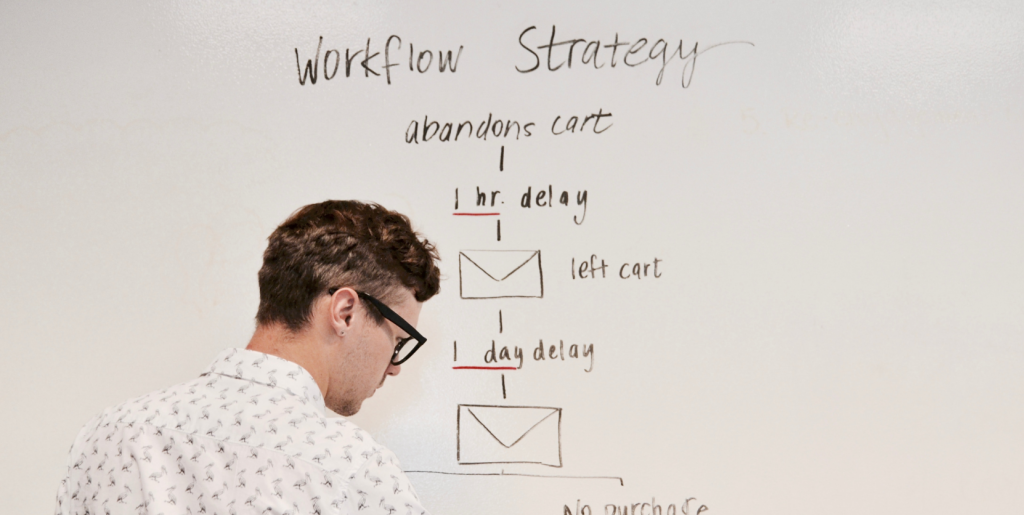
Email is a viable way to test users’ interest in your product, service, or idea. If you already have an email list of potential clients, you can leverage their feedback. Such MVP type is comparatively cheap and fast to execute.
How does it work? Create a great email campaign where you ask if your contacts are interested in joining a pre-launch waitlist and evaluate the responses. Using specialized software like Mailchimp, MailerLite, or ConvertKit, you will receive detailed statistics about how many recipients opened your email, read it, clicked on the buttons or links, etc. Analyze collected data and learn from your customers what they want. Next, plan how to build an MVP website for your startup.
3.3 No-Product MVP

Like the landing page MVP approach, it serves one purpose—validating the product idea. This includes marketing the product with the help of free and paid promotional methods and through social networks. It has become the easiest way to test a product or service idea on a broad audience.
You can gain insights into customer behavior without coding an MVP. Non-product MVP can take the shape of traditional non-tech or low-tech techniques, such as advertising campaigns, presentations, wireframes, and even some basic prototypes or demos.
The High-Fidelity MVPs include such MVP types:
3.4 Single-Feature MVP

A single-feature Minimum Viable Product approach is best used after researching your target audience and the problems you wish to solve for them. The main focus of this approach is to test the assumption of initial customers and get real feedback.
For such type of building an MVP software, you need to identify the key feature of your product or For such type of building MVP software, you need to identify the key feature of your product or service idea and how you can efficiently scale the business around it. Here’s the main question: what is the core feature that makes the essence of your app or website? An accurate answer to this question tends to define an MVP’s core functionality. As the product’s user base grows, we can add secondary features.
3.5 Wizard-Of-Oz MVP and Concierge
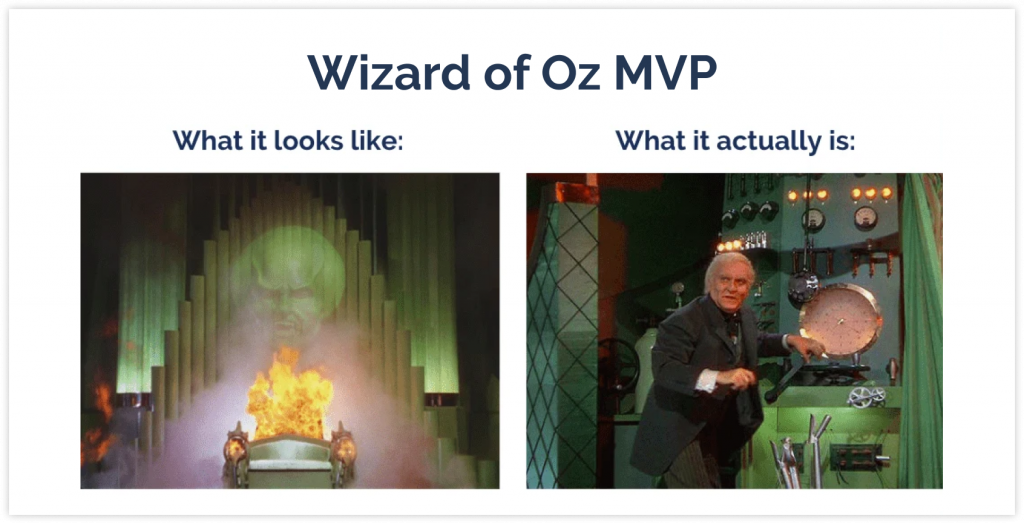
The Wizard of Oz MVP building is much like the concierge MVP. Both types of MVP websites are manually operated, like the wizard in the Wizard of Oz. The essential difference between them is that the MVP Wizard of Oz type seems like an automated experience for the customer. Still, the concierge type is fully operated by humans to provide the user experience.
Instead of investing in a complicated back-end codebase, most of the effort of creating a minimum viable product goes into building a refined front end. It impresses the user and introduces the product. If you execute it correctly, customers will assume that the technology is already in place.
Such methods aim to test the viability of a seamless experience. Once the concept has been experimented with and gained enough returning visitors, you can be confident in creating your full-featured service or product. Then it would be logical to invest in further rounds of MVP development and incorporate more technological aspects.
3.6 Piecemeal MVP

One more cost-effective way to present a product to customers is to build a Piecemeal MVP. The idea is to use existing tools and solutions to provide your product features. Countless digital tools allow all sorts of interactions between users. By creatively aligning these tools, it is possible to build a whole new type of service.
For example, you can offer goods or coupons from other stores in your catalog and use third-party services for order delivery. Piecemeal MVP startup uses all the advantages of existing products to help solve your clients’ problems.
3.7 Which MVP Type Is Right for Your Startup?
Get creative! Each MVP type works for different goals and different products. You can merge several types of MVP approaches through your development process. Each kind of MVP helps to run cost-effective and effort-effective experiments uniquely. Each of them delivers meaningful results for further development.
The most important thing for you is to determine the fastest and cheapest way to learn about your customers. Creating MVP allows you to estimate interest in the unique selling proposition and understand your target audience.
Need help choosing the MVP type?
4. Minimum Viable Product Examples
The most successful Minimum Viable Products don’t stay startups for too long. In fact, you’ve certainly heard of most of these — although you may not have known that they were MVPs once.

On February 14, 2005, YouTube was founded, originally meant to be a dating website. The idea was dumped by April when the first video was uploaded. Young engineers from PayPal, Chad Hurley, Steve Chen, and Jawed Karim, created a simple service that allowed users to upload videos up to 10 mins easily and comparatively quickly. At the time, the creators of YouTube had no idea that their startup would become one of the most influential sites in the world.
The early YouTube homepage was ascetic by today’s standards, with only five videos, a search box, and some video tags to explore. YouTube’s first video player had a huge logo watermark on the bottom and very few controls. For example, there was no timer or fullscreen button, which is standard for us today. But it didn’t matter for fans of the site at that time. YouTube’s popularity grew rapidly.
It began as a venture capital-funded startup that raised funds from diverse investors, including $11.5 million from Sequoia Capital and $8 million from Artist Capital Management. In July 2006, there were already 100 million users and 65k videos. In October 2006, Google announced the purchase of YouTube for $1.65 billion. Today YouTube is the most favored video hosting platform globally and the 2nd most popular search engine after Google.
In this example, we can see that an MVP in web development is an experiment that gives us insights from our users. Sometimes they are unexpectedly different from our assumptions and can pivot the whole MVP development process, and it’s OK!
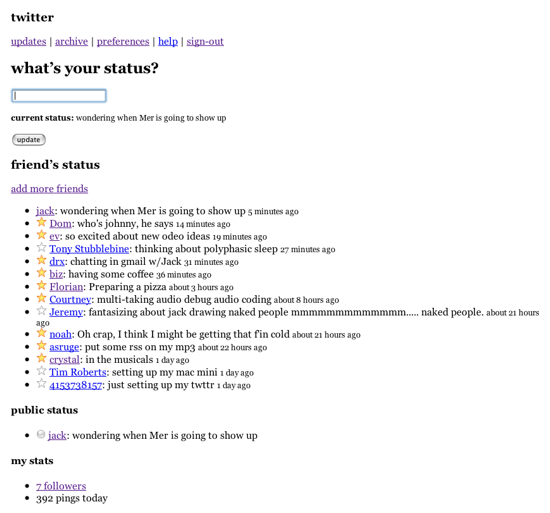
Twitter thrives by having 320 million monthly active users, up 422% in the past twelve months. Co-founder Biz Stone named it “the messaging system we didn’t know we needed until we had it.”
How did this happen? What was the key element of their startup that led to its success? Four developers from the podcasting company Odeo — Jack Dorsey, Noah Glass, Biz Stone, and Evan Williams created an online service to share short messages with coworkers.
Initially, co-founder and author of the idea, Jack Dorsey, imagined Twitter as an SMS-based communications platform to exchange statuses with groups of friends, letting others know what they’re doing.
They suggested a system where a user could send SMS to one number and further dispatch it to the recipient’s friends. The first version of this platform was named “Twittr”. Odeo employees liked the service and spent lots of time on messaging.
The founders saw the potential and gave the green light to develop a web interface. Released to a broad audience in July 2006, Twitter met real success in 2007, with 60k daily tweets.
As frequently happens in MVP startup projects, new features arise through experiments and real user insights. For example, hashtags weren’t always an integral part of Twitter. In 2007 former Google designer Chris Messina was the first who proposed to use it. He simply asked users what they thought about it. After he received positive feedback, hashtags became a new standard and changed the social media world.
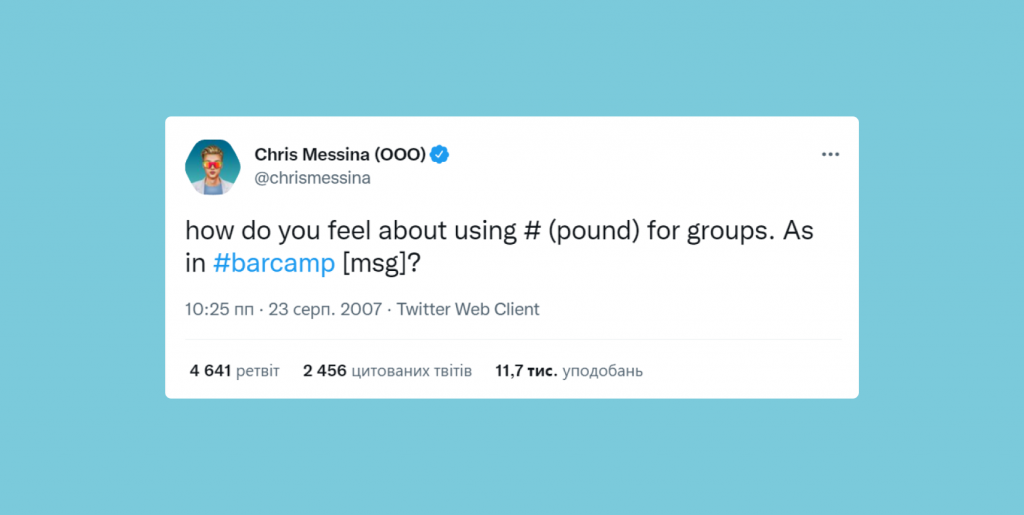
As we can see on the Twitter example, the most famous MVP websites do not always thrive due to their sophisticated technologies. MVPs succeed when they go out to the public and meet the desires and trends at a given time. During MVP startup development, it is vital to explore the market and provide new creative solutions constantly. In reality, people won’t say to you: “It would be so cool if you’d create a micro-blogging website where I could post up to 140 characters and follow other people”. Twitter’s success story demonstrates Erik Ries thought:
Customers don’t know what they want. There’s plenty of good psychology research that shows that people are not able to accurately predict how they would behave in the future. So, asking them, ‘Would you buy my product if it had these three features?’ or ‘How would you react if we changed our product this way?’ is a waste of time. They don’t know.
Erik Ries
Etsy

One more successful minimum viable product example is Etsy, which has evolved from MVP to a huge commerce platform. In 2005, Chris Maguire, Jared Tarbell, Rob Kalin, and Haim Schoppik were fed up with building websites for clients and wanted to build something of their own.
After they built and maintained a crafting community forum called GetCrafty.com, they received a new idea from their users. Chris Maguire, a co-founder of Etsy, recalls, “They kept saying on the [GetCrafty] forums at the time, “I wish there were a place to sell things that I made, like eBay’s too expensive and unwieldy. And there’s not really a whole lot out there that, you know, caters to just us”. Maguire and his co-founders thought about it and then answered, “We could build that.” An easy-to-use platform for selling handmade products without high fees.
The first version of the MVP took around two and a half months to complete. It was a big surprise when the website with basic functionality and primitive design got thousands of sign-ups in a few days. Today Etsy has grown from a simple idea into one of the biggest e-commerce companies in the world. About 95 million people used Etsy in 2021 to buy or sell.
The main secret of this MVP startup example is to choose a narrow niche and an excellent tech stack behind it. However, as Etsy’s CTO Kellan Elliott-McCrea admitted:
One thing that’s inevitable is change. We haven’t figured out every solution and probably will never do. Sometimes the things we think are true will be wrong the next day, and vice versa.
5. Steps To Build an MVP For Startups
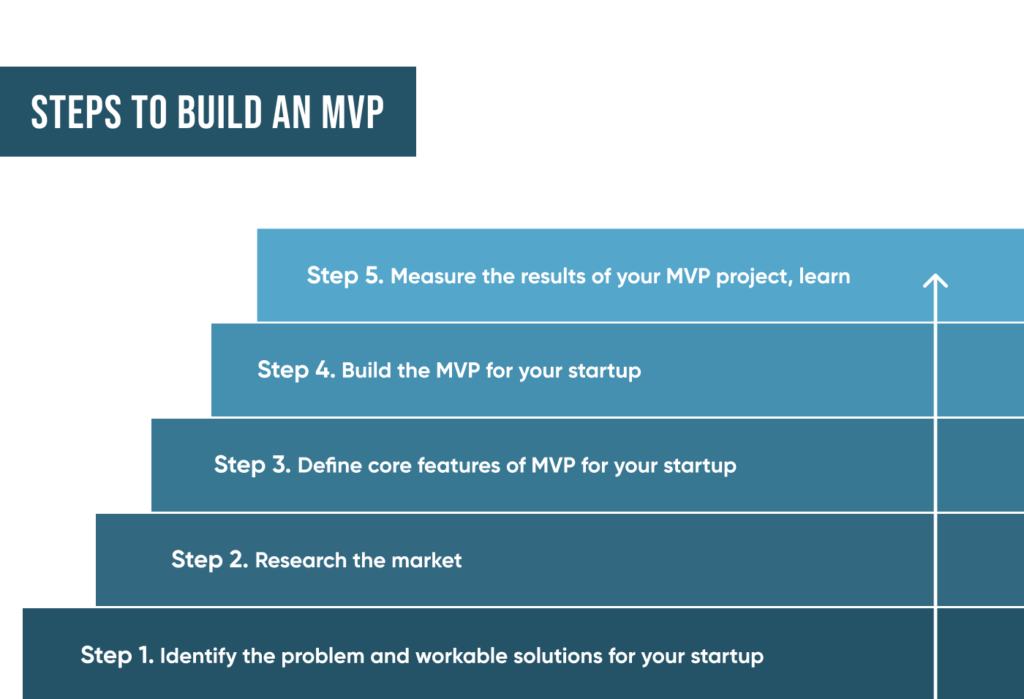
The best thing about building an MVP is that it allows you to introduce a new product to the market in the shortest terms and with core features. The main point here is to get the attention of the initial consumers and receive their feedback. In this part we would like to share with you a step-by-step guide of how to build a minimum viable product.
There are 5 basic steps to build an MVP:
Step #1. Identify the problem and workable solutions for your startup
Again, it’s all about your customers. First of all, you should ask yourself, “What exact problem of my clients am I trying to solve? What solutions are they currently using? How can I solve their problem better?“
A deep understanding of the problem helps you to focus on your customers’ jobs to be done. With a clear vision of jobs to be done, you can learn what is valuable to the customers and dismiss uncertainty.
Moreover, you have to understand who will buy your products. What delights them, and what upsets them? Narrow down your target audience. The specific users have specific requirements, which would help you define your MVP’s features and functionality. Create a user persona: age, gender, demographics, job title, income, challenges, what devices they use, and how.
Step #2. Research the market
Check existing or similar solutions on the market. Competitors’ research would help you to discover pitfalls and avoid them. Market research gives your MVP the right direction and lets you stay on top of what your customers want and how much they’re willing to pay.
Gather statistics, reports, studies, and other data from organizations. Plenty of information is free for entrepreneurs on a tight budget. For example, you can use LinkedIn. Select the search bar and enter the name of the industry you’re seeking. Then, under “More,” select “Companies” to narrow your results to the businesses that include this or a similar industry term on their profile.
Step #3. Define core features of MVP for your startup
Narrow down your focus to one or two key components to building your MVP. Yeah, it’s hard, but it is necessary.
The MVP engineering aims to build something that can be released as soon as possible. To do that, you have come to the absolute essence of your product. Start to remove features until you get to that point when you remove one more thing that won’t be your product.
Write down all the ideas that you have about your perfect future product. Once you’ve done it, start to prioritize them. For this, you can use – must-haves, should-haves, could-haves, and won’t-haves approach.
It is also a clever idea to score all the features by relevance or importance. As a result, you would know what to add in future iterations first and what can wait.
After that work is done, you will lead your idea down to absolute essence.
Step #4. Build the MVP for your startup
Once you’ve approved the central concept of your product and defined the basic functionality, you’ll need to go through the MVP design and development stage. You can find a dedicated team who have already worked on similar projects to save your time and money. How to Find Your Perfect Dedicated Team read here. Start with wireframing the homepage and navigation. To make your MVP more cost-efficient, choose only one platform for the experiment, web, iOS, or Android.
One more important point! MVP software shouldn’t be launched with poor functionality or bugs. It can immediately drive away initial customers, you’ll receive negative feedback, and it can affect a company’s reputation. MVP technology needs to be accurately functioning, even if it currently only twists around a single feature. That is why it received the name “viable product”.
Not sure where to find an experienced team? Contact us, and experts from AMgrade would be happy to assist with your successful MVP launch.
Need an experienced team to implement the MVP?
Step #5. Measure the results of your MVP project, learn, and iterate
Even though it might be scary, reach out to prospective customers for their direct feedback. If they are excited about your upcoming product launch after seeing your MVP, you just found something worth building.
Remember that a negative result is also a result. Your MVP might go through several iterations of the build–measure–learn cycle before you have a high-fidelity winning MVP.
6. Success Metrics of Minimum Viable Product
If you are wondering how to measure an MVP’s success, we can give you some tips. Here are the most common, effective, and proven 10 methods to measure MVP success metrics:
- Word of Mouth. Start interviewing your first users/customers. List the problems they may face and ask what they think about it.
- User Engagement Rate. Any interaction with your app or website determines your engagement rate. It might be likes, comments, views, shares, mentions, messages, etc. The metric helps in analyzing the progress of your MVP. You can calculate it by dividing total engagement by total users multiplied by 100.
- Active Users (Daily, Weekly, and Monthly). Compare all three and conclude your client’s satisfaction and interactions.
- Session Length. The time a user spends on your website or app during one session can also measure whether your MVP is worthy or not.
- Sign-Up. Sign-ups are a workable way to measure user interest. They may also boost the revenue by raising interest in the product.
- The number of downloads and launch rates. Here, we can add that the lighter the app is, the more downloads it will get.
- Client Acquisition Cost (CAC). The startup owners should check how much it costs to get a paying customer. Such MVP metrics help to measure efforts in marketing and correct development strategy. The formula is
CAC = [Money spent on traction channel] / [Number of customers acquired through the channel]
- Number of Paying Users. Know the average revenue per user (ARPU) and keep track of products that bring revenue.
ARPU = [Total income for the day]/[Number of active users]
- Client Lifetime Value (CLV). CLV demonstrates how much time a user spends on the app before uninstalling or discontinuing their app use.
CLV = ([Profit from a user]*[App usage duration]) – [Acquisition cost]
- Churn Rate. Churn displays the percentage of users who uninstalled or stopped using the app.
Churn = [Number of churns per week or month]/[Number of users at the beginning of the week or month]
7. Common Mistakes That Can Cause MVP Startup Failure
As we can see, a Minimum Viable Product web development has great potential. However, some MVP launches don’t turn out as expected. In all such cases, there are some common reasons.
When we start working on the MVP project, we have to keep in mind 3 things: Minimum, Viable, and Product.
Minimum
Cut down everything unnecessary. Get rid of everything extra when you build MVP software; leave only the main value for the user. Thus, no beauty. Don’t dive into design, make a simple working prototype, and don’t waste resources. It is about seeing if you can raise money from the idea.
Viable
The MVP should work to deliver one, core value. Don’t waste resources on complicated and long backend development. Don’t let perfect be the enemy of good. However, if your product won’t offer the expected minimum standard of quality, it can fail.
Product
Your MVP product has to be something tangible, unique, and relevant to the market. So here, we recommend you do not skip the discovery phase. To check The Discovery Phase Steps Guidelines read here. Do your research. Validate your idea before starting to develop an MVP. Don’t try to imitate already existing products. Go your own way.
Want to avoid the risks with your MVP?
There are also many other pitfalls that can cause your MVP to fail.
Targeting the wrong audience in MVP launching
Sometimes, because of a lack of discovery or superficial understanding of the problem, you may not target your audience. In that case, you can pivot your strategy, do more research, and iterate testing.
Ignoring users’ feedback during minimum viable product development

Always listening to your users is not as easy as it seems. Sometimes it feels like you are overloaded with proposals and claims. You are trying to be nice to everyone and getting lost. Yet if you don’t listen to your users, you don’t know them. If you don’t understand them, ignore their suggestions – you can’t create a valuable product.
Gather as much information as possible about the people who interact with your MVP product. Every input determines the output of a product and your future success.
Incompetent team on your MVP project
It seems like finding and hiring a dedicated team is the last thing you have to care about, right? But a dedicated development team would be your trusted partner during the whole MVP web development process. They would brainstorm, create, and back up your product. Try to find someone experienced and who shares your passion for encouraging your ideas. If you want to find out more about How to Hire a Dedicated Development Team check here. With the right dedicated software development partner, you receive not just a workforce but a fairy godmother who can bring your dream to life.
8. Conclusion
Building an MVP is a process focused on hypothesis testing, measuring, and learning. It is about speed. Thus, an MVP is the best idea to save time, costs, and resources for entering the market. It does not have to be perfect, but it must be viable. Follow the MVP steps, examples, and strategies described, and get ready for a quick launch.
Note that creating MVP for startups is a technique that empowers entrepreneurs to discover a lot about their users. The transparency that the product is an MVP is key to ensuring customer satisfaction. All you need is to specify the problem, identify the main MVP feature, learn your target audience, and find the right development company that would be your reliable partner in this exciting journey.
If you decide to make an MVP for your startup, we’d be glad to help you. We can help you to determine the core functionality and choose the right MVP approach to product development. Get a FREE consultation from our developers Contact us.